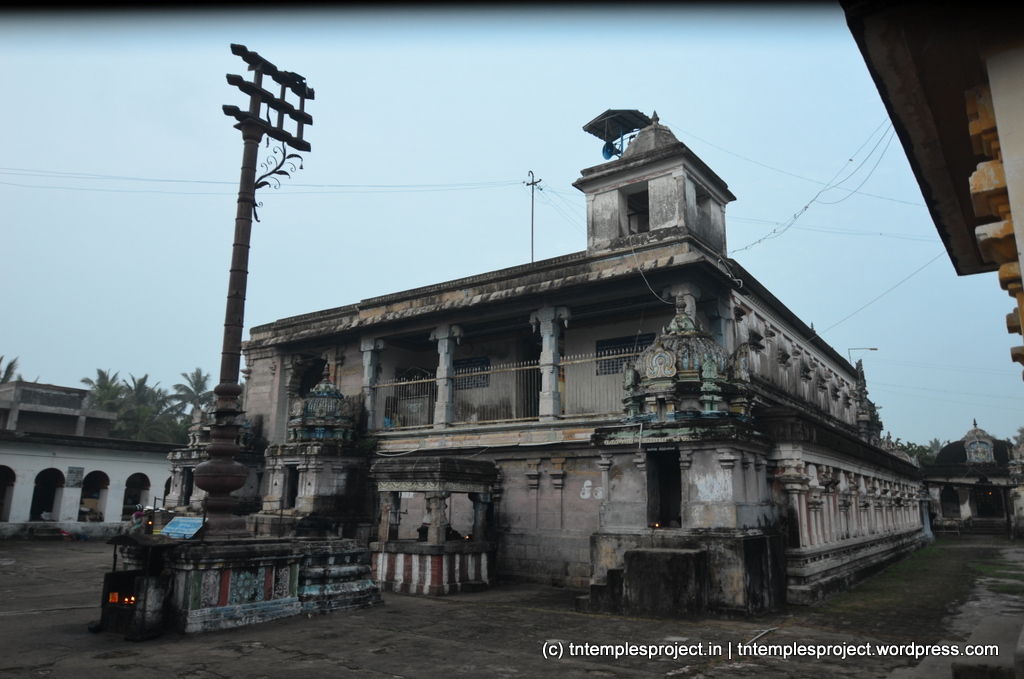Basic information about the temple
| Moolavar: | Deva Pureeswarar | Ambal / Thayar: | ThenmozhiyaaL |
| Deity: | Siva | Historical name: | Thevur |
| Vriksham: | Velvazhai | Teertham: | Deva Teertham |
| Agamam: | Age (years): | ||
| Timing: | 6 to 12 & 4 to 8 | Parikaram: | |
| Temple group: | Paadal Petra Sthalam (Kaveri Then Karai) | – | |
| Sung by: | Temple set: | ||
| Navagraham: | Nakshatram: | ||
| City / town: | Thevur | District: | Tiruvarur |
| Maps from (click): | Current location | Nagapattinam (16 km) | Nagapattinam (16 km) |
| Mayiladuthurai (53 km) | Kumbakonam (56 km) |
Location
Sthala puranam and temple information
Thevur (or Devur) gets its name from the sthala puranam here that Devas worshipped Lord Siva here. Vritrasura, a demon, was harassing the Devas. After a lot of battle, Indra killed the demon, but as a result, he was afflicted with Brahmahathi dosham. Because Indra was the chief of the Devas, the sin attached to the other Devas as well. To be cleansed of the sin, all the Devas worshipped Siva here. Since the Lord blessed them at this place, He is called Deva Pureeswarar or Deva Gurunathar (although this term is usually used for Dakshinamurti here).

The temple’s sthala puranam is connected with both the Ramayanam and Mahabharatam. Similar to the sthala puranam at Keezh Velur, Kubera worshipped here after losing his wealth, which had been stolen by Ravana. He was blessed with not just his wealth, but also his consorts Sanga Nidhi and Padma Nidhi. Another connection with the Ramayanam has to do with Hanuman. On his return from Lanka, Hanuman offered his prayers to, and was blessed by, Siva here. There is a separate shrine for Rudra Anjaneyar, facing south towards Lanka.
In the Mahabharatam, Virata (the king in whose kingdom, the Pandavas spent the 13th year of their exile, incognito) and his son Uttara worshipped Lord Siva here. It is believed that Uttara also established a separate temple for Siva as Uttaresamudaiyar, nearby.
The temple is a prarthana sthalam for those seeking to get married, and those seeking children.
Those who have worshipped here include the Devas, Kubera, Sage Gautama, Indra, Suryan, Brhaspati, and others.
There are some interesting aspects relating to iconography at this temple. Since Brhaspati (Guru) worshipped here, and Siva Himself has the stature of Adi-Guru, there is no depiction of Muyalagan at Dakshinamurti’s shrine here – in a sense, ignorance is removed for those worshipping at this temple.
This is one of the 78 maadakoil temples built by Kochchenga Cholan. The structural temple is dated to the early Chola period, and subsequent additions and renovations were carried out by the Vijayanagara Dynasty, Thanjavur Nayaks, and more recently, the Nagarathar community. Inscriptions in the temple also refer to grants by the Pandya king, Jatavarman Sundarapandyan.

The Durga at this temple is unique. In Siva temples, the Durga on the north or northeast is usually Vishnu Durga (depicted with sangu / conch and chakram, similar to Vishnu), and in rare cases is a Siva Durga (depicted with a deer and an axe, similar to Siva). However, at this temple, Durga is a Siva-Vishnu Durga, and is depicted holding the sangu, chakram, deer and axe in her four hands!
There is a shrine for Murugan between the shrines of Siva and Parvati, and because of this arrangement, this place is regarded as a Somaskandar sthalam.
The sthala vriksham – vazhai (plantain tree) – is unique here, in that it grows even today, despite being based on a stone platform and not embedded in the earth. For this reason, it is called the Kal-vazhai (Kal in Tamil means stone). The devas are said to have worshipped Siva with bananas from this tree.
Other information for your visit
Contact
Phone: 94862 78810
Gallery

























